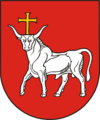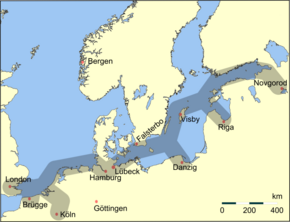Kaunas
| Kaunas | |||
| — City municipality — | |||
 |
|||
|
|||
| Nickname(s): Laikinoji sostinė | |||
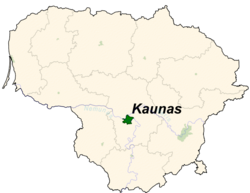 |
|||
| Coordinates: | |||
| Country | |||
|---|---|---|---|
| Ethnographic region | Suvalkija | ||
| County | Kaunas County | ||
| Municipality | Kaunas city municipality | ||
| Capital of | Kaunas County Kaunas city municipality Kaunas district municipality |
||
| First mentioned | 1361 | ||
| Granted city rights | 1408 | ||
| Boroughs |
List
|
||
| Area | |||
| - Total | 157 km² (60.6 sq mi) | ||
| Population (2008) | |||
| - Total | 355,550 | ||
| Time zone | EET (UTC+2) | ||
| - Summer (DST) | EEST (UTC+3) | ||
| Website: http://www.kaunas.lt/3 | |||
Kaunas (, pronounced /ˈkoʊnəs/) is the second largest city in Lithuania and a former temporary capital. It is served by the freeways Via Baltica (E67) and Vilnius-Klaipėda (A1). Kaunas is located at the confluence of the two largest Lithuanian rivers, the Nemunas and the Neris, and near the Kaunas Reservoir, the largest body of water entirely in Lithuania.
Contents |
Name
The city's name is of Lithuanian origins and most likely derives from a personal name.[1]
Before Lithuania regained independence, the city was generally known in English as Kovno, the traditional Slavicized form of its name; the Polish name is Kowno. The traditional Russian name is Ковно, although Каунас has been used since 1940. The Yiddish name is Kovne (קאָװנע), while its names in German include Kaunas and Kauen.
Coat of arms
In June 30, 1993 the historical coat of arms of Kaunas city was established by a special presidential decree. The coat of arms features a white aurochs with a golden cross between his horns, set against a deep red background. The aurochs is the original heraldic symbol of the city since 1400. The current emblem was the result of much study and discussion on the part of the Lithuanian Heraldry Commission, and realized by the artist Raimondas Miknevičius. An aurochs has replaced a wisent, depicted in the Soviet era emblem, used since 1969.
History
Grand Duchy of Lithuania





On the site of the current Kaunas old town at the confluence of two large rivers, a settlement had been established by the tenth century AD. It is believed that the town was founded in 1030, but it is first mentioned in written sources in 1361. In the thirteenth century, a stone wall was built as protection from constant raids by the Teutonic Knights. In 1362, the town was captured by the Teutonic Knights, who destroyed the Kaunas Castle. The castle was rebuilt at the beginning of the 15th century.
In 1408 the town was granted Magdeburg Rights by Vytautas the Great and became a center of Kaunas Powiat in Trakai Voivodeship in 1413. Kaunas then began to gain prominence, since it was at an intersection of trade routes and a river port. In 1441 Kaunas joined the Hanseatic League, and Hansa merchant offices were opened. By the 16th century, Kaunas had a public school, a hospital, and a drugstore, and was one of the best-formed towns in the Grand Duchy of Lithuania.
In 1665, the Russian army attacked the city several times, and in 1701 the city was occupied by the Swedish army. The Black Death struck the area in 1657 and 1708, and fires destroyed parts of the city in 1731 and 1732.
Russian Empire
After the final partition of the Polish-Lithuanian state in 1795, the city was occupied by the Russian Empire and became a part of Vilna Governorate. During the French invasion of Russia in 1812, the Grand Army of Napoleon passed through Kaunas twice, devastating the city both times.
After the Partitions, Kaunas was one of the centres of the November Uprising (1830-1831) and the January Uprising (1863-1864). To suppress the local population, the Russian authorities subsequently placed a huge military garrison in the town. The Russian military fortifications from that time still survive throughout the town.
Kovno Governorate with a center in Kovno (Kaunas) was formed in 1843. In 1862 a railway connecting the Russian Empire and Germany was constructed, making Kaunas a significant railway hub with one of the first railway tunnels in the Empire, completed in 1861. In 1898 the first power plant started operating.
Inter-war Lithuania
After Vilnius was occupied by the Russian Bolsheviks in 1919, the government of the Republic of Lithuania established its main base here. Later, when Vilnius was seized by Poland, Kaunas became the interim capital of the Lithuanian government, a position it held until 1939, when Poland was partitioned between Nazi Germany and the USSR. Stalin returned Vilnius to Lithuania, and the process of moving the capital was initiated. Before it was complete, however, the whole country was occupied by the Soviet Union.
Between the World Wars industry prospered in Kaunas; it was at the time the largest city in Lithuania. Under direction of the mayor Jonas Vileišis (1921-1931) Kaunas grew rapidly and was extensively modernised. A water and wastewater system, costing over 15 million Lithuanian litas, was put in place; the city expanded from 18 square kilometers to 40; more than 2,500 buildings were built, including three modern bridges over the Neris and Nemunas rivers. All the city streets were paved, horse-drawn transportation was replaced with modern bus lines, new suburbs were planned and built (Žaliakalnis neighborhood in particular), new parks and squares were established. The foundations for a social security system were laid, three new schools were built, and new public libraries, including the Vincas Kudirka library, were established. Vileišis maintained many contacts in other European cities, and as a result Kaunas was an active participant in European urban life.
During the inter-war period Kaunas had a Jewish population of 35,000-40,000, about one-fourth of the city's total population [2]. Jews were concentrated in the city's commercial, artisan, and professional sectors. Kaunas was also a center of Jewish learning. The yeshiva in Slobodka (Vilijampolė) was one of Europe's most prestigious institutions of higher Jewish learning. Kaunas had a rich and varied Jewish culture. The city had almost 100 Jewish organizations, 40 synagogues, many Yiddish schools, 4 Hebrew high schools, a Jewish hospital, and scores of Jewish-owned businesses. It was also an important Zionist center.
Soviet occupation
In 1940 Kaunas was annexed by the Soviet Union as part of the Lithuanian SSR. 14 June 1941 marked the beginning of mass arrests, executions and deportations of citizens to Siberia and other parts of Russia. After the outbreak of German invasion into USSR on 23 June an uprising began in Kaunas and short-lived period of independence was proclaimed in Kaunas on June 23, 1941.
The Tragedy of Kaunas' Jews
Jewish life in Kaunas was first disrupted when the Soviet Union occupied Lithuania in June 1940. The occupation was accompanied by arrests, confiscations, and the elimination of all free institutions. Jewish community organizations disappeared almost overnight. Soviet authorities confiscated the property of many Jews while hundreds were exiled to Siberia. Meanwhile, the Lithuanian Activist Front, founded by Lithuanian nationalist émigrés in Berlin, disseminated anti-semitic literature in Lithuania.[3] Among other themes, the literature blamed Jews for the Soviet occupation.
Following Germany's invasion of the Soviet Union on June 22, 1941, Soviet forces fled Kaunas. Immediately before and following the German occupation of the city on June 25, the anti-Communist German organized insurgents began to attack Jews, blaming them for Soviet repressions, especially along Jurbarko and Kriščiukaičio streets.[4] They murdered hundreds of Jews and took dozens more Jews to the Lietūkis garage, in the city center, and killed them there.
The Nazis eventually established the Kaunas Ghetto, which by the end of the war would be nearly completely liquidated.[5]
Modern times
After World War II Kaunas became the main industrial city of Lithuania – it produced about a quarter of Lithuania's industrial output.
After the proclamation of Lithuanian independence in 1991, Soviet attempts to suppress the rebellion focused on the Sitkūnai Radio Station, which were a critical part of the remaining free media. They were defended by the citizenry of Kaunas.
Demography
Historical population
| Year | Inhabitants |
|---|---|
| 1796 | 8,500 |
| 1813 | 3,000 |
| 1825 | 5,000 |
| 1840 | 8,500 |
| 1860 | 23,300 |
| 1897 | 71,000 |
| 1923 | 92,000 |
| 1940 | 154,000 |
| 1959 | 214,000 |
| 1966 | 275,000 |
| 1989 | 418,087 |
| 2001 | 378,943 |
| 2004 | 366,652 |
| 2005 | 361,274 |
Ethnic composition
With almost 93 percent of its citizens being ethnic Lithuanians, Kaunas is one of the most Lithuanian cities in the country. Kaunas has a higher proportion of ethnic Lithuanians than Vilnius, and more ethnic Lithuanians than Riga has ethnic Latvians or Tallinn has ethnic Estonians.

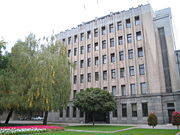
Ethnic composition in 2001, out of a total of 378,943:[6]
- Lithuanians 352,051
- Russians 16,622
- Ukrainians 1,906
- Poles 1,600
- Other 6,764
Municipality council
Kaunas city municipality council is the governing body of the Kaunas city municipality. It is responsible for municipality laws. The council is composed of 41 member elected for four-year terms.
The council is the member of The Association of Local Authorities in Lithuania.
Mayors
- 1990–1991 – Vidmantas Adomonis
- 1991–1992 – Vilimas Čiurinskas
- 1992–1995 – Arimantas Račkauskas
- 1995 – Rimantas Tumosa
- 1995–1997 – Vladas Katkevičius
- 1997 – Alfonsas Andriuškevičius
- 1997–2000 – Henrikas Tamulis
- 2000 – Vytautas Šustauskas
- 2000 – Gediminas Budnikas
- 2001–2002 – Erikas Tamašauskas
- 2002–2003 – Giedrius Donatas Ašmys
- 2003–2007 – Arvydas Garbaravičius
- since 2007 – Andrius Kupčinskas
Geography

Administrative divisions
Kaunas is divided into 11 elderates
|
|
Neighborhoods
Cityscape
Points of interest

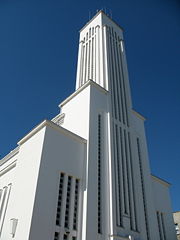
Central Kaunas is defined by two pedestrian streets: the 2-km-long Laisvės alėja (Liberty Avenue), a central street of the city, lined by linden trees, and its continuation, Vilnius Street, leading to the oldest part of Kaunas. Some of the most prominent features in Kaunas include:
- the Kaunas Castle, a 14th century fortification;
- the Vytautas' Church, one of the oldest churches in Lithuania and the oldest in Kaunas;
- the Kaunas Cathedral Basilica, the largest Gothic building in Lithuania, with a late Baroque interior;
- the St. George's Church, which was rumoured to have been turned into a dance studio during the Soviet Occupation;
- the Pažaislis abbey, an impressive complex in Baroque style;
- the massive Neo-Byzantine church of St. Michael the Archangel;
- the Christ’s Resurrection Church with an unfolding panoramic view of the city;
- Kaunas Zoo, the only state-operated zoo in Lithuania;
- Kaunas Fortress, a 19-20th century military fortress, which includes a Holocaust site of the Ninth Fort;
- Kaunas Botanical Garden;
- Napoleon's Hill;
- House of Perkūnas;
- Town Hall and the square;
- Interbellum functionalism architecture complexes;
- The Žaliakalnis Funicular Railway;
- Ąžuolynas Park and the valley of Girstupis River named after Adam Mickiewicz.
Museums
Kaunas is often called a city of museums, because of the abundance and variety of them. The museums in Kaunas include:
- the War Museum of Vytautas the Great;
- the M. K. Čiurlionis State Art Museum, commemorating the work of the early 20th century avant-garde artist who sought to combine painting and music into a single artistic medium;
- a gallery of works collected by Mykolas Žilinskas at the Kaunas Art Gallery;
- the Žmuidzinavičius Museum (best known as the Devils' Museum), which houses a collection of more than two thousand sculptures and carvings of devils from all over the world, most of them of folk provenance. Of particular interest are the Hitler and Stalin devils, together doing the dance of death over a playground littered with human bones;


- Aviation Museum;
- Ceramics Museum in the Town Hall of Kaunas;
- Communications History Museum;
- Kaunas Picture Gallery, with a little exhibition about George Maciunas, founding member of the Fluxus-movement, born in Kaunas;
- Lithuanian Sports Museum;
- Medicine and Pharmacy Museum;
- Historical Presidential Palace, displaying exhibits from the interwar period
- Museum For The Blind;
- Museum of Exiles and Political Prisoners;
- Museum of Folk Music and Instruments;
- Tadas Ivanauskas Zoological Museum.
Theatres
- Kaunas State Drama Theatre
- Kaunas State Musical Theatre
- Kaunas Youth Chamber Theatre
- Kaunas State Puppet Theatre
- Kaunas Little Teatre
Public art
A great deal of sculptuary is on display in the public areas of Kaunas.
Transportation
Kaunas has 16 trolleybus routes, 49 bus routes (Map), a wide shared taxi carrier network - see Kaunas Public Transport -, and it is also one of the major river ports in the Baltic States. The city is located in the centre of Lithuania, making it highly significant from a logistical point of view. Kaunas International Airport (KUN) is capable of handling 300,000 passengers and 100,000 tonnes of cargo per year. There is also the smaller S. Darius and S. Girėnas Airport south of town.
Bridges

Since Kaunas is located on confluence of two rivers in the city are 34 bridges.
- Vytautas the Great Bridge connecting Old Town with Aleksotas across Nemunas,
- M. K. Čiurlionis Bridge for car transport across Nemunas,
- Vilijampolė Bridge connecting Old Town with Vilijampolė across Neris River,
- The Green railway bridge.
Sports
Kaunas is home to the Žalgiris basketball club, one of Europe's strongest, which plays home matches in Kaunas Sports Hall. The city is also the birthplace or childhood home of many of the country's top basketball stars, among them Arvydas Sabonis, Šarūnas Marčiulionis, Žydrūnas Ilgauskas, Linas Kleiza and Šarūnas Jasikevičius. The main stadium of the city is S.Dariaus ir S.Girėno Sporto Centras (total capacity 9,000), which is also the Lithuanian soccer club FBK Kaunas's and Lithuanian national football team home stadium.
Education

Kaunas is often called a city of students; there are about 50,000 students enrolled in its universities.
- ISM University of Management and Economics
- Vytautas Magnus University
- Kaunas Business College
- Kaunas College
- Kaunas University of Medicine
- Kaunas University of Technology
- Lithuanian Academy of Physical Education
- Lithuanian University of Agriculture
- Lithuanian Veterinary Academy
- Vilnius University Kaunas Faculty of Humanities
- Kaunas Art Institute
Annual events
- Kaziukas Fair Kaunas fork (beginning of March)
- International open-air "Kaunas Jazz Festival" (April-May)
- International dance competition "Amber Couple" (beginning of May)
- Day of Kaunas city (middle of May)
- International poetry festival "Spring of poetry" (end of May)
- Pažaislis music festival (June-August)
- Traditional folk music competition "Play, Jurgelis" (November)
- Christmas tree lighting (end of November)
- Kaunas Textile Art Biennial (next from November 2007 until March 2008)
Notable residents

- Valdas Adamkus [7]
- Aharon Amir
- Donatas Banionis
- Aharon Barak
- Antanas Baranauskas
- Marija Gimbutas
- Emma Goldman
- Juozas Grušas
- Žydrūnas Ilgauskas
- Tadas Ivanauskas
- Valdas Ivanauskas
- Šarūnas Jasikevičius
- Romas Kalanta
- Linas Kleiza
- Vytautas Landsbergis
- Emmanuel Levinas (philosopher)
- George Maciunas
- Maironis
- Abraham Mapu
- Šarūnas Marčiulionis
- Adam Mickiewicz
- Hermann Minkowski
- Oskar Minkowski
- Vlado Perlemuter (pianist)
- Michał Pius Römer (lawyer, judge)
- Arvydas Sabonis
- Mykolas Sleževičius
- Jonas Vileišis
- Vytautas Šliumba (Former Soaring Champion)
- Vytautas Žalakevičius
- L. L. Zamenhof (inventor of the Esperanto language)
- Erika Kilmanaite(runs the office at Traders Gate)
Trivia
- Two of the country's three funiculars are located in Kaunas.
- The main pedestrian street in the city, Laisvės alėja (Liberty Avenue), is one of the longest pedestrian streets in Europe.
- National hero Romas Kalanta committed self-immolation in Kaunas in protest against the Soviet occupation of Lithuania.
- Emma Goldman, the celebrated proponent of anarchism, was born in Kaunas.
- It is a sister city of Los Angeles.
- Sugihara Street commemorates the Japanese consul who issued thousands of exit visas to Lithuanian and Polish Jews during his World War II service in Kaunas. His home in Kaunas is now a museum.
- Sacha Noam Baron Cohen's (Ali G, Borat) paternal great grandfather was born in Kaunas
Footnotes and references
Notes
- This article incorporates text from the United States Holocaust Memorial Museum, and has been released under the GFDL.
External links
- Website of Kaunas city
- Kaunas Web Page by Jose Gutstein
- Kaunas tour overview
- Kaunas In Your Pocket City Guide (also a downloadable PDF guide)
- The city of Kaunas
- A short description of Kaunas
- Historic images of Kaunas
- Kaunas International Airport
- Kovno site and Kovno stories links by Eilat Gordin Levitan
- Museums in Kaunas
- The Kaunas Jazz festival
- Kaunas Textile Art Biennial
- Kauno mozaika - the project of urban photography
- Public transportation in Kaunas (omnibuses, trolleybuses)
- Tourist Information Centre of Kaunas region
- Kaunas Travel Guide (tips about Kaunas)
- United States Holocaust Memorial Museum - Kovno
|
||||||||||||||||||||||||||
|
|||||||||||
|
|||||||||||||||||
